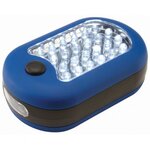campus189
Member level 5

- Joined
- May 7, 2011
- Messages
- 84
- Helped
- 0
- Reputation
- 0
- Reaction score
- 0
- Trophy points
- 1,286
- Location
- Tennessee,USA
- Activity points
- 1,940
**broken link removed**
Hopefully someone can help me here..
I want to run this 24 led light on a 12 volt car battery. This will be for when the power goes out.
I want to run about 4 of these if I can in my house with the battery being charged by a 4 watt solar battery charger in the day.
It takes 3 AAA Batteries & draws about 480mA , a little less than ½ an amp. And has a voltage reading of 4.7 Volts
I tried using LM317 & 7805 on a bread board, they both heat up a lot.
Without the led light hooked up, I used a potentiometer and got the voltage to a perfect 4.5 volts DC
When I connect the led light it dims big time and the heat sink heats up big time.
I got a feeling that the resistor values may be wrong.
I tried to use the LM317 resistor calculator, but am still having problems..
Any idea what I am doing wrong? I don’t want to spend tons of money trying to figure this out.
If someone could give me some idea as to what to use for resistors or something else, it would be greatly appreciated..
Thank You
Hopefully someone can help me here..
I want to run this 24 led light on a 12 volt car battery. This will be for when the power goes out.
I want to run about 4 of these if I can in my house with the battery being charged by a 4 watt solar battery charger in the day.
It takes 3 AAA Batteries & draws about 480mA , a little less than ½ an amp. And has a voltage reading of 4.7 Volts
I tried using LM317 & 7805 on a bread board, they both heat up a lot.
Without the led light hooked up, I used a potentiometer and got the voltage to a perfect 4.5 volts DC
When I connect the led light it dims big time and the heat sink heats up big time.
I got a feeling that the resistor values may be wrong.
I tried to use the LM317 resistor calculator, but am still having problems..
Any idea what I am doing wrong? I don’t want to spend tons of money trying to figure this out.
If someone could give me some idea as to what to use for resistors or something else, it would be greatly appreciated..
Thank You
Attachments
Last edited:



